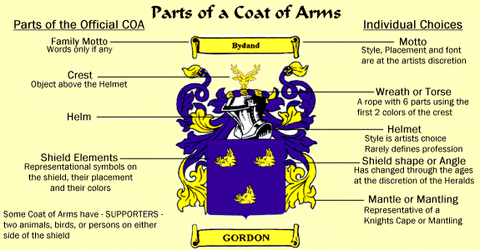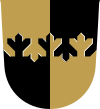Symbolism in Heraldry
Posted by Jeff Ezzell on
One of the most distinctive qualities of heraldry is the use of a limited palette of colors and patterns, usually referred to as tinctures. These are divided into three categories, known as metals, colors, and furs.
The metals are or and argent, representing gold and silver, respectively, although in practice they are usually depicted as yellow and white. Five colors are universally recognized: gules, or red; sable, or black; azure, or blue;vert, or green; and purpure, or purple; and most heraldic authorities also admit two additional colors, known as sanguine or murrey, a dark red or mulberry colour between gules and purpure, and tenné, an orange or dark yellow to brown colour. These last two are quite rare, and are often referred to as stains, from the belief that they were used to represent some dishonourable act, although in fact there is no evidence that this use existed outside the imagination of the more fanciful heraldic writers. Perhaps owing to the realization that there is really no such thing as a stain in genuine heraldry, as well as the desire to create new and unique designs, the use of these colors for general purposes has become accepted in the twentieth and twenty-first centuries. Occasionally one meets with other colors, particularly in continental heraldry, although they are not generally regarded among the standard heraldic colors. Among these are cendrée, or ash-color; brunâtre, or brown; bleu-céleste or bleu de ciel, sky blue; amaranth or columbine, a bright violet-red or pink color; and carnation, commonly used to represent flesh in French heraldry. A more recent addition is the use of copper as a metal in one or two Canadian coats of arms.
Furs
There are two basic types of heraldic fur, known as ermine and vair, but over the course of centuries each has developed a number of variations. Ermine represents the fur of the stoat, a type of weasel, in its white winter coat, when it is called an ermine. It consists of a white, or occasionally silver field, powdered with black figures known as ermine spots, representing the black tip of the animal's tail. Ermine was traditionally used to line the cloaks and caps of the nobility. The shape of the heraldic ermine spot has varied considerably over time, and nowadays is typically drawn as an arrowhead surmounted by three small dots, but older forms may be employed at the artist's discretion. When the field is sable and the ermine spots argent, the same pattern is termed ermines; when the field is or rather than argent, the fur is termed erminois; and when the field is sable and the ermine spots or, it is termed pean.
Vair represents the winter coat of the red squirrel, which is blue-grey on top and white underneath. To form the linings of cloaks, the pelts were sewn together, forming an undulating, bell-shaped pattern, with interlocking light and dark rows. The heraldic fur is depicted with interlocking rows of argent and azure, although the shape of the pelts, usually referred to as "vair bells", is usually left to the artist's discretion. In the modern form, the bells are depicted with straight lines and sharp angles, and meet only at points; in the older, undulating pattern, now known as vair ondé or vair ancien, the bells of each tincture are curved and joined at the base. There is no fixed rule as to whether the argent bells should be at the top or the bottom of each row. At one time vair commonly came in three sizes, and this distinction is sometimes encountered in continental heraldry; if the field contains fewer than four rows, the fur is termed gros vair or beffroi; if of six or more, it is menu-vair, or miniver.
A common variation is counter-vair, in which alternating rows are reversed, so that the bases of the vair bells of each tincture are joined to those of the same tincture in the row above or below. When the rows are arranged so that the bells of each tincture form vertical columns, it is termed vair in pale; in continental heraldry one may encounter vair in bend, which is similar to vair in pale, but diagonal. When alternating rows are reversed as in counter-vair, and then displaced by half the width of one bell, it is termed vair in point, or wave-vair. A form peculiar to German heraldry is alternate vair, in which each vair bell is divided in half vertically, with half argent and half azure.[All of these variations can also be depicted in the form known as potent, in which the shape of the vair bell is replaced by a T-shaped figure, known as a potent from its resemblance to a crutch. Although it is really just a variation of vair, it is frequently treated as a separate fur.
When the same patterns are composed of tinctures other than argent and azure, they are termed vairé or vairy of those tinctures, rather than vair; potenté of other colors may also be found. Usually vairé will consist of one metal and one colour, but ermine or one of its variations may also be used, and vairé of four tinctures, usually two metals and two colours, is sometimes found.
Three additional furs are sometimes encountered in continental heraldry; in French and Italian heraldry one meets with plumeté or plumetty, in which the field appears to be covered with feathers, and papelonné, in which it is decorated with scales. In German heraldry one may encounter kursch, or vair bellies, depicted as brown and furry; all of these probably originated as variations of vair.
Considerable latitude is given to the heraldic artist in depicting the heraldic tinctures; there is no fixed shade or hue to any of them.
Whenever an object is depicted as it appears in nature, rather than in one or more of the heraldic tinctures, it is termed proper, or the color of nature. This does not seem to have been done in the earliest heraldry, but examples are known from at least the seventeenth century. While there can be no objection to the occasional depiction of objects in this manner, the overuse of charges in their natural colors is often cited as indicative of bad heraldic practice. The much-maligned practice of landscape heraldry, which flourished in the latter part of the eighteenth and early part of the nineteenth century, made extensive use of such non-heraldic colors.
One of the most important conventions of heraldry is the so-called "rule of tincture". To provide for contrast and visibility, metals should never be placed on metals, and colors should never be placed on colors. This rule does not apply to charges which cross a division of the field, which is partly metal and partly color; nor, strictly speaking, does it prevent a field from consisting of two metals or two colors, although this is unusual. Furs are considered amphibious, and neither metal nor color; but in practice ermine and erminois are usually treated as metals, while ermines and pean are treated as colors. This rule is strictly adhered to in British armory, with only rare exceptions; although generally observed in continental heraldry, it is not adhered to quite as strictly. Arms which violate this rule are sometimes known as "puzzle arms", of which the most famous example is the arms of the Kingdom of Jerusalem, consisting of gold crosses on a silver field.
Variations of the field
Divisions of the field
The field of a shield in heraldry can be divided into more than one tincture, as can the various heraldic charges. Many coats of arms consist simply of a division of the field into two contrasting tinctures. These are considered divisions of a shield, so the rule of tincture can be ignored. For example, a shield divided azure and gules would be perfectly acceptable. A line of partition may be straight or it may be varied. The variations of partition lines can be wavy, indented, embattled, engrailed, nebuly.
Ordinaries
There is a separate class of charges called sub-ordinaries which are of a geometrical shape subordinate to the ordinary. According to Friar, they are distinguished by their order in blazon. The sub-ordinaries include the inescutcheon, the orle, the tressure, the double tressure, the bordure, the chief, the canton, the label, and flaunches.
Ordinaries may appear in parallel series, in which case blazons in English give them different names such as pallets, bars, bendlets, and chevronels. French blazon makes no such distinction between these diminutives and the ordinaries when borne singly. Unless otherwise specified an ordinary is drawn with straight lines, but each may be indented, embattled, wavy, engrailed, or otherwise have their lines varied.
Charges
Animals are found in various stereotyped positions or attitudes. Quadrupeds can often be found rampant (standing on the left hind foot). Another frequent position is passant, or walking, like the lions of the coat of arms of England. Eagles are almost always shown with their wings spread, or displayed. A pair of wings conjoined is called a vol.
In English heraldry the crescent, mullet, martlet, annulet, fleur-de-lis, and rose may be added to a shield to distinguish cadet branches of a family from the senior line. These cadency marks are usually shown smaller than normal charges, but it still does not follow that a shield containing such a charge belongs to a cadet branch. All of these charges occur frequently in basic undifferenced coats of arms.



